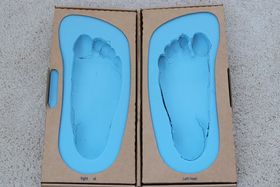Upstep Answers
Our team answers your questions about the causes and treatment of various podiatric conditions, including plantar fasciitis, flat feet, foot pain, and the use of custom orthotics.
Recent Answers
Are Pre-Made Orthotic Shoes as Good as Custom-Made Orthotics in Treating Overpronation?
If you have overpronation that's significant enough to require a pair of orthotics to try and correct the problem, then you're going to face the choice between shelling out a lot of money to get a pai
Asked 4 years ago
How Long Should It Take for Custom Orthotic Insoles to Give Relief?
Custom orthotics are designed to reshape your feet and force them to work the way they should, which can be uncomfortable at first. Depending on the condition that you intend to treat, it might take s
Asked 4 years ago
What Shoes Can You Put Orthotics In?
When it comes to orthotics, many people wonder what type of shoes you can put them in. While over-the-counter orthotics can work with any shoe type, custom orthotics present a better alternative. Apa
Asked 4 years ago
Would Orthotics Help With Arthritis in My Toes?
Orthotics can help reduce foot pain caused by arthritis. They can make it easier to live with arthritis, but orthotics won't cure the condition. However, they can provide your arthritic toes with the
Asked 4 years ago
Related Articles

How to Reduce Pain from Past Injuries to Improve Quality of Life
Upstep Staff
December 20, 2024

Treatments for Plantar Plate Tears
Babafemi Adebajo
October 4, 2024

Conservative and Invasive Treatments for Flat Feet
Janik Sundstrom
December 17, 2024

DIY Orthotics: Risks of DIY & Safe Custom Alternatives
Janik Sundstrom
June 24, 2025

Are Birkenstocks Really Good for All Feet? A Podiatrist's Review
Janik Sundstrom
May 13, 2025
Recent Posts
Janik Sundstrom
DIY Orthotics: Risks of DIY & Safe Custom Alternatives
Upstep Staff
Best Insoles for Managing Overpronation
Janik Sundstrom
Best Cycling Shoe Insoles to Provide Arch Support
Janik Sundstrom



